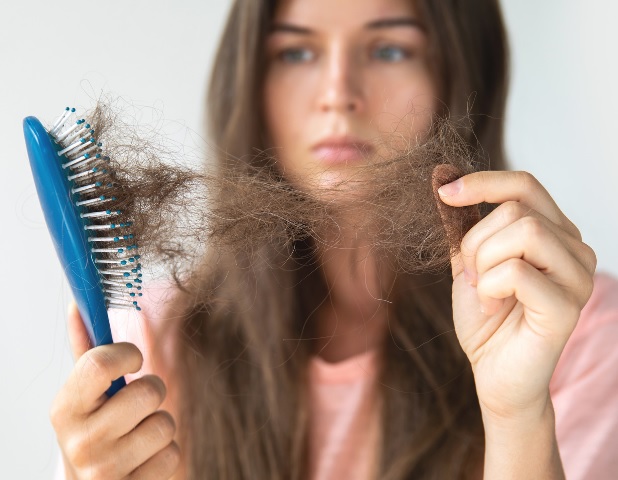
Female Hair Loss: What Are your Options?
Baldness in women, also known as female pattern baldness or androgenetic alopecia, is a common condition that can affect women of all ages. While it is more prevalent in postmenopausal women, it can also occur in younger women.
Here are some key points about baldness in women:
Causes
Genetics: Just like in men, genetics plays a significant role in female pattern baldness. If there is a family history of hair loss, a woman may be more prone to experiencing it herself.
Patterns of Hair Loss: Female pattern baldness typically presents as diffuse thinning on the crown of the head rather than a receding hairline, as is often seen in men. Hair loss may be more noticeable during menopause when estrogen levels decline.
Diagnosis
A healthcare professional, usually a dermatologist, can diagnose the cause of hair loss by examining the scalp, reviewing medical history, and possibly conducting blood tests to identify underlying health issues.
Treatment
Topical Minoxidil: This over-the-counter medication is commonly used to treat female pattern baldness. It can help stimulate hair growth and slow down hair loss.
Prescription Medications: Some medications, such as spironolactone or finasteride, may be prescribed to address hormonal imbalances contributing to hair loss.
Supplementation: Some non-medical hair supplements have shown to be effective for reducing hair fall, and supporting the function of healthy hair growth. HR23+ is the market leader, with 91% of female users noticing visible improvements in their hair within just 2-3 months.
Hair Transplantation: In some cases, hair transplantation may be an option, where hair follicles are moved from areas of good hair growth to areas where hair is thinning.
Lifestyle and Styling Tips
Healthy Lifestyle: Maintaining a healthy lifestyle, including a balanced diet and regular exercise, can support overall well-being, including hair health.
Gentle Hair Care: Avoiding harsh hairstyles, excessive heat styling, and tight hairstyles can help minimize damage to the hair.
Hormonal Changes: Hormonal fluctuations, such as those that occur during pregnancy, childbirth, menopause, and certain medical conditions, can contribute to hair loss.
Medical Conditions: Some health conditions, like polycystic ovary syndrome (PCOS), thyroid disorders, and autoimmune diseases, can lead to hair loss in women.
Certain Medications: The use of certain medications, such as those for cancer, arthritis, depression, heart problems, gout, and high blood pressure, may cause hair loss as a side effect.
Coping with hair loss: Key tips
Experiencing hair loss as a woman can be emotionally challenging, and coping with it involves a combination of practical and emotional strategies.
Here are some suggestions to help cope with female hair loss:
Consult with a Healthcare Professional:
Schedule an appointment with a dermatologist or healthcare provider to determine the cause of your hair loss. Identifying and addressing the underlying issue is crucial for effective treatment.
Educate Yourself:
Understand the type of hair loss you’re experiencing. Knowing the cause can help you make informed decisions about treatment options and expectations.
Consider Counselling or Support Groups:
Hair loss can have a significant impact on self-esteem and body image. Seeking support from a counselor, therapist, or joining support groups where individuals share their experiences can be beneficial.
Explore Treatment Options:
Discuss treatment options with your healthcare provider. This may include topical medications like minoxidil, prescription medications, or other therapies based on the cause of your hair loss.
Acceptance and Positive Self-Image:
Embrace your natural beauty and focus on aspects of yourself that are not related to physical appearance. Developing a positive self-image can help boost confidence.
Experiment with Hairstyles:
Consult with a hairstylist who specializes in hair loss or thinning hair. They can suggest flattering hairstyles that help minimize the appearance of thinning hair.
Consider Wigs or Hairpieces:
Wearing wigs, hairpieces, or extensions can be a temporary solution while waiting for treatment to take effect or as a long-term option if desired.
Protect Your Hair:
Be gentle with your hair. Avoid hairstyles that pull or stress the hair shaft, and minimize the use of heat styling tools. Choose hair care products that are gentle and suitable for your specific hair type.
Maintain a Healthy Lifestyle:
Focus on overall well-being by maintaining a balanced diet, staying hydrated, and engaging in regular exercise. These lifestyle factors can contribute to both physical and emotional health.
Connect with Others:
Share your experiences with friends, family, or a support group. Connecting with others who have gone through similar challenges can provide emotional support and practical tips.
Consider Camouflage Techniques:
Makeup, powders, and hair-thickening products can be used to camouflage thinning areas and create the illusion of fuller hair.
Remember that coping with hair loss is a personal journey, and what works for one person may not work for another. It’s essential to find strategies that align with your preferences and comfort level.
If you find that the emotional impact is significant, seeking professional help from a counsellor or therapist can be valuable in navigating the emotional aspects of hair loss.


Leave a Reply